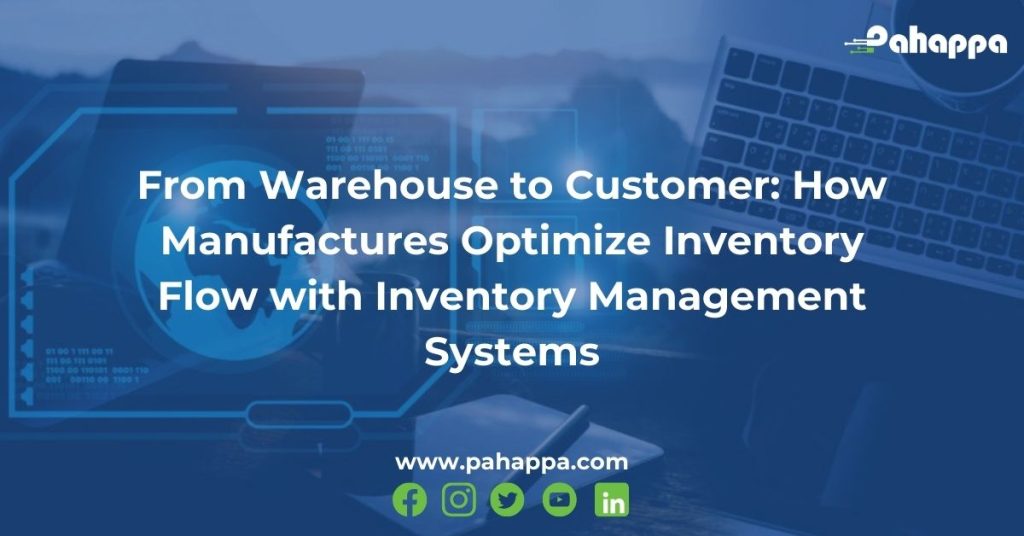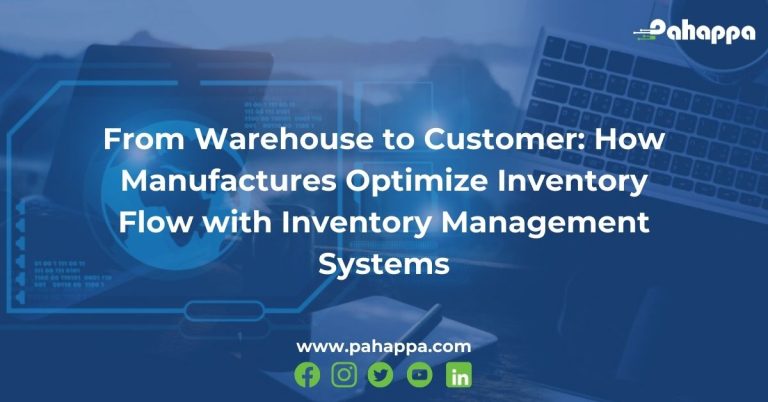Blog
Categories

Inventory management systems play a critical role in optimizing the flow of inventory from warehouses to customers for manufacturers. Without IMS tools, companies would find it hard to know what to restock and when. Demand forecasting on products would also be an issue.
These systems utilize technology to efficiently track, manage, and control inventory levels throughout the supply chain. So if you are a manufacturer, it is easy to track and monitor your inventory flow and even predict how much you should restock in the future.
Here’s how you, a manufacturer, can use an inventory management system to optimize inventory flow:
- Real-time Inventory Tracking: Inventory management systems provide real-time visibility into inventory levels across multiple locations, including warehouses, distribution centers, and retail stores. Manufacturers can monitor inventory levels accurately, enabling them to make informed decisions about restocking, replenishment, and order fulfillment.
- Demand Forecasting: How wonderful it would be to know what your customers need and when! Advanced inventory management systems utilize historical sales data, market trends, and predictive analytics to forecast future demand accurately. Manufacturers can anticipate customer demand and adjust inventory levels accordingly, minimizing stockouts and excess inventory.
- Automated Replenishment or Restocking: Inventory management systems automate the restocking process by setting up reorder points and triggering purchase orders when inventory levels drop below predefined thresholds. This automation ensures that manufacturers maintain optimal inventory levels without manual intervention, reducing stockouts and overstocking.
- Optimized Order Fulfillment: By integrating inventory management systems with order management systems and fulfilment centres, manufacturers can streamline the order fulfilment process. Orders are automatically routed to the nearest warehouse or fulfilment centre with available inventory, reducing shipping costs and delivery times.
- Inventory Optimization: Inventory management systems help manufacturers optimize inventory levels. This can be done by identifying slow-moving or obsolete inventory and implementing strategies to minimize carrying costs. Manufacturers can also implement just-in-time (JIT) inventory practices to reduce excess inventory and improve cash flow.
- Warehouse Efficiency: Inventory management systems optimize warehouse operations by organizing inventory, optimizing storage space, and simplifying picking, packing, and shipping processes. Manufacturers can reduce labour costs, improve order accuracy, and increase warehouse efficiency by implementing barcode scanning, RFID technology, and automated workflows.
- Supplier Collaboration: Inventory management systems facilitate collaboration with suppliers by sharing real-time inventory data, demand forecasts, and production schedules. Manufacturers can work closely with suppliers to ensure timely replenishment of raw materials and components, reducing lead times and improving supply chain reliability.
- Performance Analytics: Inventory management systems provide comprehensive reporting and analytics capabilities, allowing manufacturers to track key performance indicators (KPIs) such as inventory turnover, fill rates, and order accuracy. Manufacturers can identify areas for improvement and implement continuous process improvements to optimize inventory flow and enhance overall supply chain performance.
Inventory management systems play a crucial role in optimizing the flow of inventory from warehouses to customers for manufacturers. Through technology, automation, and data-driven insights, manufacturers can minimize stockouts, reduce carrying costs, improve warehouse efficiency, and enhance customer satisfaction. If you would like to know more about Inventory Management Systems, Visit us here.

An e-commerce site is a virtual shop for your products. But it does not only serve as a shop. With an e-commerce site, you can build a community and hub of followers who move from just normal viewers of your site to loyal customers and brand ambassadors. And how do they do that? By building credibility and trust. Building trust and establishing credibility with your e-commerce audience is crucial for success in the competitive online marketplace. For one, it increases sales. It also builds your business as a long-lasting brand. Imagine all those e-commerce websites in Africa and the world that always attract even the least technical shoppers. How do they build their brands and build trust?
Here are some effective strategies to achieve this:
- High-Quality Products and Services: Offer products and services of genuine quality that meet or exceed customer expectations. Consistently delivering value will help build trust over time. It is also easier to get customer reviews and recommendations when your products are of quality.
- Transparent Policies: Communicate your policies regarding shipping, returns, refunds, and customer support. Transparency fosters trust by ensuring customers know what to expect when they interact with your business.
- Customer Reviews and Testimonials: This is one of the most important aspects you need when developing an e-commerce website. Encourage satisfied customers to leave reviews and testimonials. Positive feedback from real customers serves as social proof and helps build credibility.
- Secure Payment Options: Use secure payment gateways and display trust badges to reassure customers that their financial information is safe. There are a number of secure payment gateways in Africa like Flutterwave or even PayPal.
- Clear Contact Information: Make it easy for customers to contact you by providing clear contact information, including email, phone number, and physical address. Because you are dealing with transactions, customers need to know that they can be able to access you. This improves transparency. And promptly respond to inquiries and concerns to demonstrate your commitment to customer service.
- Content Marketing: Create valuable content such as blog posts, articles, and videos related to your industry or products. By providing helpful information, you position yourself as an authority in your niche and gain the trust of potential customers.
- Social Media Engagement: Engage with your audience on social media platforms by responding to comments, addressing concerns, and sharing relevant content. Building a strong social media presence humanizes your brand and facilitates trust.
- Consistent Branding: Maintain a consistent brand image across all touchpoints, including your website, social media profiles, packaging, and marketing materials. Consistency builds recognition and trust over time.
- Customer Satisfaction Guarantee: Offer a satisfaction guarantee or warranty to reassure customers that they can shop with confidence. This demonstrates your commitment to standing behind your products and ensures customer satisfaction.
- Personalized Shopping Experience: Utilize data analytics and personalization techniques to tailor the shopping experience to each customer’s preferences and behavior. Personalization enhances customer trust by showing that you understand their needs and preferences.
- Ethical Business Practices: Conduct your business with integrity and honesty. Be transparent about your business practices, such as sourcing materials, manufacturing processes, and environmental impact. Ethical behavior builds trust and fosters long-term customer relationships.
By implementing these strategies consistently, you can establish credibility with your e-commerce audience and differentiate your brand in a crowded marketplace. Building trust takes time and effort, but the long-term benefits are invaluable for sustainable growth and success. So get started with your own e-commerce website today. Click here.

You might be wondering if an Inventory Management System is for you. But if you distribute products of any kind, then tracking supplier orders and product flow is a priority to you. The IMS modules we offer 3 modules: Production, Inventory, and Shipping module. This system tracks products from their supplier raw materials to the delivery of the finished product to the consumer. Inventory management systems are essential for a wide range of businesses and organizations across various sectors. Here are some examples:
- Retail Businesses: These are businesses that sell goods to final consumers. They use IMS software to track stock coming in and out of the business. The IMS software also helps forecast or predict products that could be in demand. Stock will always be available even during hectic seasons like the Christmas and Easter holidays. Examples of businesses in this sector include:
- Supermarkets
- Department stores
- Convenience stores
- Specialty retailers (e.g., electronics stores, clothing stores)
- Manufacturing Companies: Manufacturing companies are perhaps the ones that benefit most from IMS software. Because they manufacture products, IMS software can be used in this sector to its fullest form. With the production module, manufacturing companies can get insights and reports from supplier orders they make, and measure raw material variances. They can use the shipping module to ship products to different locations and use the inventory module to manage stock in and out of the warehouses. Here are a few examples of manufacturing companies that can benefit from the IMS software:
- Automobile manufacturers
- Electronics manufacturers
- Pharmaceutical companies
- Food and beverage producers
- Wholesale Distributors: Just like retail distributors, wholesale distributors sell stock, but not to the final consumer. Wholesale distributors sell in bulk and so they buy in bulk as well. Because many of these distributors have warehouses in different locations, there is need for warehouse management software. Wholesale distributors also use IMS to track inventory in and out of their warehouses. These are examples of businesses in this sector:
- Distributors of consumer goods
- Industrial equipment distributors
- Wholesale suppliers of raw materials
- E-commerce Businesses: E-commerce businesses use IMS software to track their inventory. The software can also be use to predict demand of stock. Since e-commerce businesses sell directly to consumers, they find it very important not to overstock or understock their products. Also because this is online shopping, e-commerce stores do not have enough warehouse storage for goods. Having a way to track what is being sold becomes very important to the growth of the business. Here are some examples of e-commerce businesses:
- Online retailers
- Drop shipping businesses
- Fulfillment centers
- Healthcare Facilities: Because Healthcare facilities provide ,medication, there is need to track medicine stock. It is also important to track orders from different suppliers that procure different medicine. An IMS software helps automate all this. These are some of the businesses in the healthcare sector:
- Hospitals
- Clinics
- Pharmacies
- Hospitality Industry: Almost everyday the hospitality industry procures commodities from different department like food, sanitation, or even sports equipment. But how can they keep track of what they procure? having and Inventory Management system helps them know what is missing and how much has stock is left in particular departments. Here are examples of businesses in the Hospitality industry:
- Hotels
- Restaurants
- Catering services
- Logistics and Transportation Companies: Because Logistics companies do a lot of shipping of orders, an IMS would be a great tool to track shipping orders. Here are examples of businesses in this sector:
- Freight forwarders
- Shipping companies
- Warehousing and distribution centers
- Agriculture and Farming: Once produce of harvested, commercial farms use IMS tools to transport it to different locations depending on the supply requested. IMS software can also help to forecast how much produce should be made planted for nest seasons depending on the demand analytics. Here are some examples of businesses in this sector:
- Farms
- Agricultural cooperatives
- Agribusiness companies
These sectors represent just a portion of the diverse range of businesses and organizations that benefit from implementing inventory management systems to optimize their operations, minimize costs, and improve customer satisfaction. To learn more about Inventory Management Software, Visit Us here.

The vast universe of e-commerce contains endless digital shelves and fierce competition. But one crucial element sets apart the giants from the transient. And that is customer loyalty. In an era where the consumer is exposed to a variety of options, businesses must not only attract but retain customers. So how does one create a pool of loyal customers? By building an interactive and navigational e-commerce website. Below are some of the ways e-commerce websites can help increase customer loyalty:
Crafting Seamless Experiences:
Picture this: a virtual store where navigation is intuitive, products are easily discoverable, and with an easy checkout process. Such is the hallmark of an e-commerce website that is committed to creating memorable shopping experiences. A customized e-commerce website enables users to enjoy the shopping experience at every touchpoint with benefits like responsive design to lightning-fast load times.
Building Trust Brick by Brick:
Trust forms the bedrock of any enduring relationship, and the digital realm is no exception. E-commerce websites act as guardians of trust, ensuring secure transactions, transparent pricing, and seamless customer service. Let’s be honest, by the time you are willing to give your bank account information you trust the company well enough at least to know that they can deliver. With robust encryption and stringent data protection measures, customers can shop with peace of mind, knowing their sensitive information is safeguarded.
Providing Rewards and Recognition:
With loyalty comes rewards, and e-commerce websites are masters of this. Through innovative loyalty programs and rewards schemes, businesses incentivize repeat purchases and brand advocacy. we have all shopped from sites that offer a variety of discount policies like Shein. Aliexpress for example limits your fist purchase on the site but refusing you to exceed a certain amount of money. Whether it’s earning points with every purchase, unlocking exclusive perks, or receiving personalized recommendations, customers feel valued and appreciated—a powerful catalyst for loyalty.
Use of Support Experience:
Customer support serves as the guiding light for lost souls and the solace for troubled hearts. E-commerce websites excel in providing prompt, personalized support across multiple channels, be it live chat, email, or phone. By addressing queries and concerns with empathy and efficiency, businesses not only resolve issues but also forge deeper connections with their customers. Knowing that there is someone ready to help you get the best out of your shopping experience is enough motivation for you to shop there again.
Using the Power of Data:
Data is the lifeblood of the digital age, and e-commerce websites are the conduits through which it flows. By harnessing the power of analytics, businesses gain invaluable insights into customer behavior, preferences, and purchasing patterns. Armed with this knowledge, they can tailor marketing efforts, personalize recommendations, and anticipate future needs—laying the groundwork for enduring loyalty.
Community and Connection:
In the interconnected web of cyberspace, e-commerce websites serve as hubs of community and connection. Through engaging content, vibrant social media channels, and interactive forums, businesses foster a sense of belonging among their customers. Some sites have pages dedicated to customer reviews with videos that User Generated Content buyers can post on their social media platforms. By nurturing these virtual communities, e-commerce websites transcend mere transactions, becoming catalysts for shared experiences and collective engagement.
To conclude e-commerce websites offer a great deal of satisfaction that many physical shops would even dream of achieving. And the best part is, you don’t have to leave the comfort of your own couch to make a sale. So why not set up a customized online shop today? Visit us at Plot 163, Mutesa 2 Road, Ntinda, Kampala to get started on your e-commerce website.

As a business owner seeking to improve your inventory operations, having an Inventory Management System must be a very attractive feature to incorporate into your business. And you are not alone. The adoption of IMS is on the rise globally. A study by Grand View Research forecasts that the global IMS market will reach $5.2 billion by 2025, with a compound annual growth rate (CAGR) of 6.8% from 2020 to 2025.
But what exactly is an Inventory Management System?
An Inventory management system is a software platform that tracks and monitors your inventory and stock, making it easy to report on how much produce you have brought in, how much stock you sold, and how much stock/ raw materials you will need in the future. With an IMS, companies can monitor how much they are putting into the business (production) and how much is coming out to sell to sell to the final customer (stock). Because warehouse storage is vital when companies need to store stock while awaiting customer demand, it becomes important for companies to monitor what stock will be going in and out of each warehouse at each particular location. Inventory management system technology is significantly reshaping warehouse operations by introducing automation, efficiency, accuracy, and optimization into the process of handling inventory.
Here’s how:
- Real-Time Tracking: Inventory management systems enable real-time tracking of inventory movement within the warehouse. This means warehouse managers have up-to-date information about stock levels, location, and movement, allowing for better decision-making and reduced stockouts or overstock situations.
- Automation: Advanced inventory management systems often integrate with warehouse automation technologies such as barcode scanners, RFID (Radio Frequency Identification), and IoT (Internet of Things) devices. These technologies can automate tasks like inventory counting, picking, packing, and shipping.
- Optimized Storage: Inventory management systems utilize algorithms and data analytics to carefully use storage space within the warehouse. By analyzing factors like demand patterns, and storage capacity, these systems can suggest storage locations for each item, minimizing travel time and maximizing space utilization. This synchronizes the storage according to demand in a particular location.
- Demand Forecasting: This is very important when monitoring inventory. It helps companies avoid over stocking in particular warehouses. If the demand for a product in a particular location is of an average number, demand forecasting can help monitor the patterns and and reduce excess sales. Many inventory management systems incorporate demand forecasting algorithms that analyze historical sales data and market trends to predict future demand. By accurately forecasting demand, warehouses can maintain optimal inventory levels, reducing excess inventory costs and stockouts.
- Order Fulfillment Efficiency: With inventory management systems, order fulfillment processes become more efficient. Systems can prioritize orders based on factors like urgency, order size, and shipping method, optimizing the picking and packing process to minimize order processing times and improve customer satisfaction.
- Supplier Integration: Most manufacturing companies have a variety of suppliers. The Pahappa inventory management system facilitates integration with suppliers, allowing for real-time visibility into supplier inventory levels, lead times, and order statuses. This integration enables better coordination between warehouses and suppliers, and eventually reducing stockouts.
- Data Analytics and Insights: Inventory management systems generate data about warehouse operations, inventory performance, and customer behavior. By leveraging advanced analytics tools, warehouses can gain valuable insights into their operations, identify areas for improvement, and make data-driven decisions to optimize processes further.
So now that you know how Inventory software can help automate your warehouse operations, why not procure one today? Visit us at this location to get a quote or call us to find out more.

If you sell products, then having an e-commerce website is the perfect way to launch your presence online. An e-commerce site will help you reach a new kind of client, the online shopper. These are consumers who buy products online. With an e-commerce site, you can sell your products online and build your brand. Creating a successful e-commerce website requires attention to various features and functionalities to attract customers, drive sales, and ensure a smooth shopping experience. Another benefit is brand awareness. With a website, you have a high chance of proving your company’s credibility and trust. And you can always use other forms of online presence like social media, email marketing, or even bulk SMs to bring traffic to your site.
So now that we know how important it is to have a website, let’s discover how best to get started. Designing a website is one of the most important things you can do for your business. But what do you need to design a user-friendly yet effective website? Here are 10 essential features every successful e-commerce website should have:
- User-Friendly Design: The website should have a clean and intuitive design with easy navigation. Make sure it’s responsive across all devices to cater to mobile users as well. Mobile commerce (m-commerce) is rapidly growing in Africa, driven by the increasing availability of affordable smartphones and improving internet infrastructure. Therefore having a responsive website makes it easier for mobile users to interact freely with your site.
- High-Quality Product Images and Descriptions: Clear, high-resolution images from multiple angles, along with detailed product descriptions, help customers make informed purchasing decisions. Online shoppers cannot physically handle the products that you sell to prove their authenticity or quality. So remember that these shoppers are trusting that what you show them is what they will get. It is therefore up to you to give as much clarity as you can.
- Simple Checkout Process: Streamline the checkout process to minimize cart abandonment. Offer guest checkout options and integrate popular payment gateways for convenience. In order to enable an amazing user experience, you must make sure that users get the most information in the least time possible. Users abandoning their carts may show indecisiveness or unclarity. Or they might not know how to checkout. So make it easy for the users to view the product and buy.
- Search and Filter Functionality: Implement robust search and filter options to help customers find products quickly based on categories, price range, size, color, etc. This helps users find exactly what they are looking for without spending a lot of time on your website.
- Security Measures: Ensure the security of customer data and transactions by integrating SSL certificates, using trusted payment gateways, and complying with relevant security standards. Make sure your website developers off the best payment gateways available in your country. Also provide more payment options because there might some vary according to location.
- Customer Reviews and Ratings: Allow customers to leave reviews and ratings for products. It is common knowledge that a review goes a long way. People like to see what what customers say about your product. Positive reviews build trust and credibility, influencing purchasing decisions.
Additional Features to include:
- Personalized Recommendations: Use algorithms to provide personalized product recommendations based on customer browsing and purchase history, increasing the likelihood of upselling and cross-selling.
- Responsive Customer Support: Offer multiple channels for customer support, including live chat, email, and phone support. Having someone online at at all times willing to answer customer inquiries builds trust and enhances clarity about products. Promptly address customer inquiries and concerns to enhance satisfaction.
- Easy Returns and Refunds Policy: Clearly communicate your returns and refunds policy to customers and make the process hassle-free. A lenient policy can increase customer confidence in making purchases.
- Analytics and Insights: Integrate analytics tools to track website performance, user behavior, and sales metrics. Analyzing this data can help optimize marketing strategies, improve user experience, and identify areas for growth.
By incorporating these essential features into your e-commerce website, you can enhance its functionality, attract more customers, and drive higher conversions, ultimately leading to greater success in the online marketplace. Get started with your e-commerce site today. Visit us today to get started.




